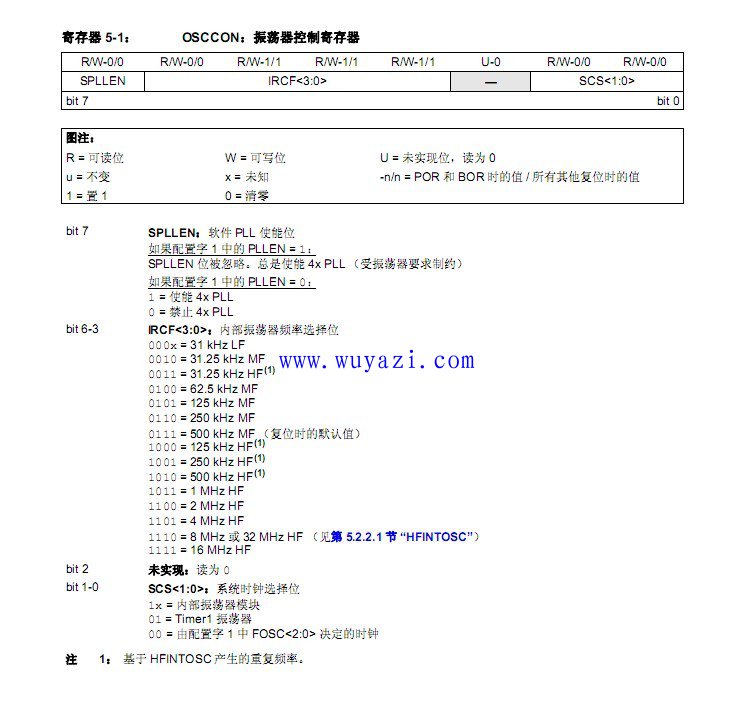Let's start by understanding what a clock is. The clock is the core component of a microcontroller, acting as the heartbeat that synchronizes all internal circuits. Think of it like the rhythm in a radio broadcast during morning exercises — when you hear "1, 2, 3, 4," everyone moves together in sync. The faster the beat, the quicker your movements; the slower the beat, the more relaxed your actions. Similarly, the microcontroller operates based on the frequency of its clock signal.
What are internal and external clocks? Many PIC microcontrollers allow you to choose between an internal RC oscillator or an external crystal, such as a 4MHz quartz. Some models even support multiple clock frequencies, offering flexibility for different applications.
Take the PIC18LF1823 as an example. It can operate with an internal clock ranging from 31kHz up to 32MHz. This wide range allows for power optimization. While sleep modes are commonly used to reduce power, the CPU remains inactive. However, by lowering the clock frequency, the CPU can still perform tasks while consuming less power — a great strategy for energy-conscious designs.
How do you configure the clock? Clock settings typically involve two main components: the configuration word and the oscillator control register (OSCCON). Let's look at the PIC18LF1823 as a case study.
The configuration word includes bits like FOSC (Oscillator Select) and PLLEN (PLL Enable). The OSCCON register controls the internal clock frequency. If you're using an external clock, this register may be ignored. Here’s a detailed breakdown of the OSCCON register from the datasheet:

Example: Setting the clock to 8MHz using the internal oscillator
Development environment: MPLAB X IDE
Chip model: PIC18LF1823
#include <xc.h>
__CONFIG(FOSC_INTOSC & WDTE_OFF & PWRTE_ON & MCLRE_OFF & CP_ON & CPD_OFF & BOREN_ON &
CLKOUTEN_OFF & IESO_ON & FCMEN_ON);
__CONFIG(PLLEN_OFF & LVP_OFF); // Set FOSC to INTOSC
void init_fosc(void) {
OSCCON = 0x70; // Set internal clock to 8MHz
}
int main(int argc, char** argv) {
init_fosc();
while(1);
}What is the PLL used for? The PLL (Phase-Locked Loop) is used to multiply the clock frequency. For instance, it can take an 8MHz signal and multiply it by 4 to produce 32MHz. Note that this only works with an 8MHz input — other frequencies cannot be used.
Example: Setting the clock to 32MHz using the internal oscillator
Development environment: MPLAB X IDE
Chip model: PIC18LF1823
#include <xc.h>
__CONFIG(FOSC_INTOSC & WDTE_OFF & PWRTE_ON & MCLRE_OFF & CP_ON & CPD_OFF & BOREN_ON &
CLKOUTEN_OFF & IESO_ON & FCMEN_ON);
__CONFIG(PLLEN_ON & LVP_OFF); // Set FOSC to INTOSC, enable PLL
void init_fosc(void) {
OSCCON = 0xF0; // Set internal clock to 8MHz and enable 4X PLL
}
int main(int argc, char** argv) {
init_fosc();
while(1);
}Understanding how to set and use the clock in microcontrollers is essential for optimizing performance and power consumption. Whether you're working with internal or external oscillators, knowing the configuration options gives you greater control over your design.
Cr12 Soldering lron,high strength and wear resistance.The cut surface of DIN Rail is smooth and free of burrs.With the 50cm lengthgraduated scale,cutting is accurate.The bezelcan be rotated at 90°,making cutting more convenient.Locking mechanism,humanized design, concenient for storage and transportation.
Crimp Tool WKC8 SeriesSuitable for VE ferrulesWKC8 10-4 Square shape after crimpedWKC8 6-6 Hexagon shape after crimped
Cutting plier ToolSuitable for cutting FBS, JEB bridges
Automatic wire stripping and crimping machineProduct introduction
This model is designed for crimping tube terminal, suitable for wires with cross section 0.5-4mm².Thedesktop type machine is space saving,Theproductionof wiring harness has strong mobility, vibration plate feeding, automatic trigger start,stripping Integratedoperation of stripping wire, insert into ferrules andcrimping is convenient and quick.It is suitable forcrimping, stripping variety of single-grain tubeterminals to wires at one time.
Touch man-machine interface numerical control operation
Stripping through the terminal without reverse wire
Horizontal crimping from left and right
Fool-proof design automatically triggers to start
Holder Bracket For Din Rail,Electric Din Rail Holder,Standard Din Rail Accessories,Din Rai Power Supply
Wonke Electric CO.,Ltd. , https://www.wkdq-electric.com